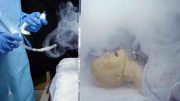
COVID-19 silent hypoxemia is baffling to physicians
Study explains potential causes for Silent Hypoxemia condition in COVID-19 patients. Findings could prevent unnecessary intubation and ventilation.
A new research study provides possible explanations for COVID-19 patients who present with extremely low, otherwise life-threatening levels of oxygen, but no signs of dyspnea (difficulty breathing). This new understanding of the condition, known as silent hypoxemia or “happy hypoxia,” could prevent unnecessary intubation and ventilation in patients during the current and expected second wave of coronavirus.
The condition “is especially bewildering to physicians as it defies basic biology,” said Martin J. Tobin, MD, Loyola Medicine and Edward J. Hines Jr. VA Hospital pulmonologist and critical care specialist, and professor, Loyola University Chicago Stritch School of Medicine. Dr. Tobin is lead author of the study, “Why COVID-19 Silent Hypoxemia is Baffling to Physicians,” appearing recently in the online American Journal of Respiratory and Critical Care Medicine.
“In some instances, the patient is comfortable and using a phone at a point when the physician is about to insert a breathing (endotracheal) tube and connect the patient to a mechanical ventilator,” said Dr. Tobin, “which while potentially lifesaving carries its own set of risks.”
The study included 16 COVID-19 patients with very low levels of oxygen (as low as 50%; normal blood oxygen saturation is between 95 and 100%), without shortness of breath or dyspnea, and found that “several pathophysiological mechanisms account for most, if not all, cases of silent hypoxemia. This includes the initial assessment of a patient’s oxygen level with a pulse oximeter.
“While a pulse oximeter is remarkably accurate when oxygen readings are high, it markedly exaggerates the severity of low levels of oxygen when readings are low,” said Dr. Tobin. “Another factor is how the brain responds to low levels of oxygen. As oxygen levels drop in patients with COVID-19, the brain does not respond until oxygen falls to very low levels — at which point a patient typically becomes short of breath,” he said.
In addition, more than half of the patients had low levels of carbon dioxide, which may diminish the impact of an extremely low oxygen level.
“It is also possible that the coronavirus is exerting a peculiar action on how the body senses low levels of oxygen,” said Dr. Tobin, which could be linked to the lack of smell, experienced by two-thirds of COVID-19 patients.
While acknowledging that further research is needed, the study concludes that “features about COVID-19 that physicians find baffling become less strange when viewed in the light of long-established principles of respiratory physiology.”
“This new information may help to avoid unnecessary endotracheal intubation and mechanical ventilation, which presents risks, when the ongoing and much anticipated second wave of COVID-19 emerges,” said Dr. Tobin.
Reference: “Why COVID-19 Silent Hypoxemia is Baffling to Physicians” by Martin J. Tobin, Franco Laghi and Amal Jubran, 15 June 2020, American Journal of Respiratory and Critical Care Medicine.
DOI: 10.1164/rccm.202006-2157CP









Dr Zach Bush suggests that it is analogous to cyanide poisonings See This interview of Dr Zach Bush on Covid-19 is worth understanding.. He explains Covid-19 in severe cases induces cyanide etc hypoxia and should not be addressed as a respiratory infection. Reverse the hypoxia in those showing severe symptoms with traditional treatments and it’s appropriately addressed, per Bush. https://youtu.be/_PI6HgoIv_U Here’s a clinical trial of sodium nitrate treatment (addressing cyanide type hypoxia) of Covid 19. https://clinicaltrials.gov/ct2/show/NCT04401527